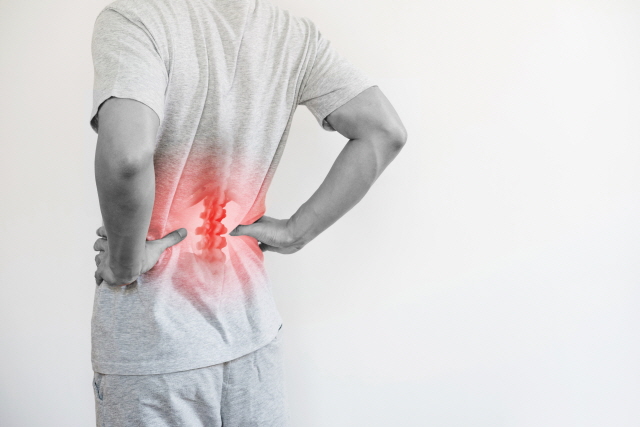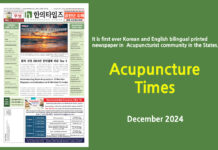
There Are Ten Formulas for LBP in Saam Acupuncture
By Namwook Cho L. Ac
This issue explores the Urinary bladder (UB) Meridian, a key treatment for low back pain in patients with a cold constitution during colder seasons.
The UB Meridian has numerous acupuncture points among all twelve meridians and spans the entire back, making it a common choice for such treatments. In Saam Acupuncture Therapy, low back pain is categorized into ten types, including Liver Junggyeok (Liver Tonification Formula), Gallbladder Junggyeok, Small Intestine Junggyeok, Spleen Junggyeok, Spleen Seunggyeok (Spleen Sedation Formula), Stomach Junggyeok, Lung Junggyeok, Large Intestine Junggyeok, Kidney Junggyeok, and Bladder Junggyeok.
UB Junggyeok is only effective for symptoms with heaviness and pain in the hips, numbness in the calves and fourth and fifth toes, or uneven leg lengths.
The role of the Urinary Bladder (UB) meridian is closely related to muscles. In particular, it is closely related to the symptoms of the muscles where the bladder meridian passes. For example, the fundamental cause of urinary problems is the bladder problem. The bladder is composed of a muscle mass governed by the UB meridian.
Also, the UB meridian could be considered to represent the characteristics of water. The name of the meridian is Foot-Taiyang UB Meridian. The Taiyang meridian is the nature of cold water, and the UB meridian itself is related to water. The eyeballs are also filled with water. Some eye problems can also be treated using the UB meridian.
Since the UB meridian belongs to a yang meridian, its physiology is to let warm Qi flow from heaven down to the feet, cooling the Qi as it descends. Suppose this physiological function is changed to be pathological and circulation is improper due to some factor. In that case, symptoms of the upper part of the body becoming hot and the lower part becoming cold appear.
First, the symptom of the upper part becoming hot can cause the crown of the head to become hot or painful, and in severe cases, cerebral hemorrhage is possible. Also, you may feel like your eyes are falling forward or have increased intraocular pressure, glaucoma, stiff neck, and high blood pressure in your head.
Also, if you go down a little further, you may experience coldness. Symptoms such as scoliosis and sciatica may occur from pain and pulling in the muscles next to the spine. You may also experience symptoms such as cold, heavy, and painful hips. Various muscle symptoms, especially numbness caused by weak muscles and ligaments in the lower back, which causes the disc nucleus to slip out and press on the nerves, are representative symptoms.
Using either the UB Junggyeok (tonifying) or (Seunggyeok) sedating formula of Saam is an essential treatment for back pain. Pain in the tailbone, sciatica, etc., can all be treated using the UB meridian formulas. However, for sciatica, you should determine whether to use the gallbladder meridian or the UB meridian by looking at the distribution of the pain. If the pain and radiating are found on the back of the thigh through UB40, then use the UB meridian. But, if the radiation is detected on the side of the thigh, you should use the bladder meridian for treatment.
UB meridian is also used for knee pain. For reference, if there is pain on the outside of the knee, the gallbladder meridian is used; if there is pain in the front, the stomach meridian is used; and if there is pain in the inside and back of the knee, the cystoscope is used. If there is inflammation in the knee, the small intestine meridian should be used. When the knee joint feels stiff due to the synovial fluid drying up, use the lung Junggyeok (tonifying formula, tonifying LU9 and SP3 and sedating LU10 and HT8). The lung Junggyeok could also be applied to reduce noise from joints with movements in general.
UB meridian can treat pain in the back of the calf, the Achilles tendon area, and problems with the lateral malleolus.
Indications of bladder Junggyeok (stimulating), Tonifying LI1 and BL67, and sedating ST 36 and BL40.
- Hypertension
Hypotonia could be treated with a heart-tonifying formula.
- Headache or stiff neck that appears at the back of the head.
- The top of the head feels tingling and cold.
- Eyeballs feel like they will fall out, and the back of the neck is stiff.
- Ocular hypertension.
- Tinnitus.
- Back and lower body feels tight and painful.
- Diabetes
- Body swells.
- Cystitis, bladder stones, enlarged prostate.
- Back pain, lumbar disc
- Scoliosis
- Pain in the inside of the knee
- Numbness or pain in the 4th and 5th toes.
- Heat and pain in the soles of the feet.
- No sensation in the soles of the feet.
- Urine is clear and does not come out well.































